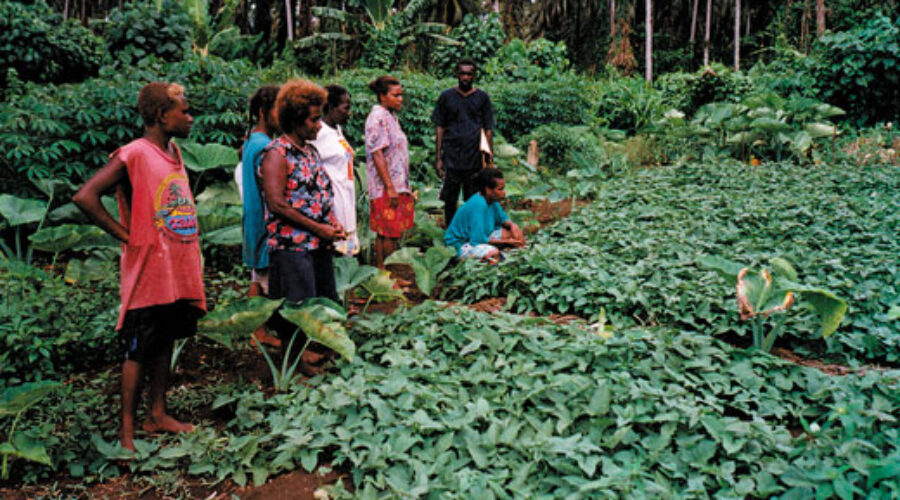Participatory approach introduces new methods to growers
PTD — Participatory Technology Development — is an approach that encourages farmers to try out new techniques, to monitor results and to make decisions about adopting new farming techniques.
The idea is that farmers:
- set aside a small area of their fields to trial a new farming technique
- monitor the new technique over time
- assess their experience of the technique and the results they obtain
- decide whether they will adopt the technique.
The PTD process familiarises farmers with management of the technique and provides the information for an informed decision about wider adoption.
The process is facilitated by a trainer or an agriculutral extension worker, usually from a development assistance organisation or government agriculture department. Their role is to set up the trial and provide training.
Adaptation to urban settings
The PTD process can be adapted form its original focus on rural development into urban agriculture, both commercial market gardening and non-commercial community gardening.
While the adaptation to market gardening would follow more or less the same format as that for rural development in lesser-developed countries, in a community food garden one allotment or an area of shared garden would be set aside for the trial of the new technique. Organised around a series of workshops over the life of the project, interested community gardeners would agree to maintain the trial when the trainer was not present between field visits (assuming the trainer in not a community gardener) and it would be assessed during workshops.
In the community gardening setting, PTD might trial alternative soil preparation to the common sheet mulched garden method, such as double digging. It might be used to trial organic methods where gardeners wish to move beyond reliance on synthetic chemical inputs or it might be used to trial the highly-productive Biointensive method of soil preparation and planting so as to compare it with other methods in use in the community garden.
This approach might be of value where an itinerant garden trainer moves between community gardens in an area as part of a skilling-up process.
Much of the PTD process that follows, and which is described in farming assistance terms, can be adapted to urban market gardening and community food gardens.
PTD:
encourages the participation of farmers in their own agricultural development
places control of the process with farmers
includes farmers in the experiment and in the assessment of the trial
leaves the decision about adopting the technique up to participating farmers
minimises risk to farmers by trialing the technique in only a limited area, avoiding the displacement of crops.
A participatory approach
PTD avoids the situation where a trainer comes into a community and imposes new ideas without the opportunity for farmers to test them.
The aim of a PTD process might include:
- improving field productivity
- limiting crop loss to insect pests and plant disease
- trialing new farming techniques and new crop varieties
- broadening the use of particular irrigation systems
- encouraging the use of particular types of agricultural inputs.
The Trainer’s role
As well as being a source of new ideas, the role of the trainer in the PTD process is that of educator and coordinator. The trainer guides farmers through the process over repeat visits, organises workshops at which farmer observations and results are shared and discusses and organises visits to the fields of participating farmers to view their implementation of the technique.
Skills in analysis, decision making and communication are needed, as are active listening, planning and organising. These interpersonal skills complement the trainer’s technical skills .
The PTD process
The PTD process takes place over a series of site visits and workshops organised by the trainer at time that will not conflict with community or cultural obligations or with farm work.
Farmer needs should already have been assessed and prioritised before the process is started, as part of the initial assessment of the project and farmer’s readiness for it. This is the baseline information collection and assessment phase and may have been done as part of a community food security assessment.
Farmers willing to try the new technique are identified and the field trials set up. The trials are conducted in only a small area of the farmers field so as to avoid crop loss if the technique proves unworkable. All workshop participants engage in setting up the trials, guided by the trainer.
Over successive workshops or field visits, the number and frequency of which are determined by the type of technique being trialed, trainer and participants visit the fields of participating farmers to assess progress, diagnose failure and difficulty and to monitor what is going on.
In the final workshop the trainer guides participants through an analysis of the field trials and their results. The trainer then assists farmers to make a decision about whether to adopt the technique if it has proved successful. The trainer encourages farmers to assist each other in adopting the technique. Throughout the process, the sharing of information is encouraged to maximise learning.
Potential problems
It may be necessary for trainers to motivate farmers to participate. The risk is that some farmers might drop out of the experiment and assessment process, especially if their own trial fails or if there develops other demands on their time.
The trainer should try to convince farmers of the value of continuing participation. How this is done would depend on the situation and the type of assistance being provided.
Increased yields, reduced crop loss to insect infestation, increased earnings at market and improved nutritional health might prove sufficient as motivator.
Reading:
van Veldhuizen, 1997; Developing Technology With Farmers; Zed Books, London.

